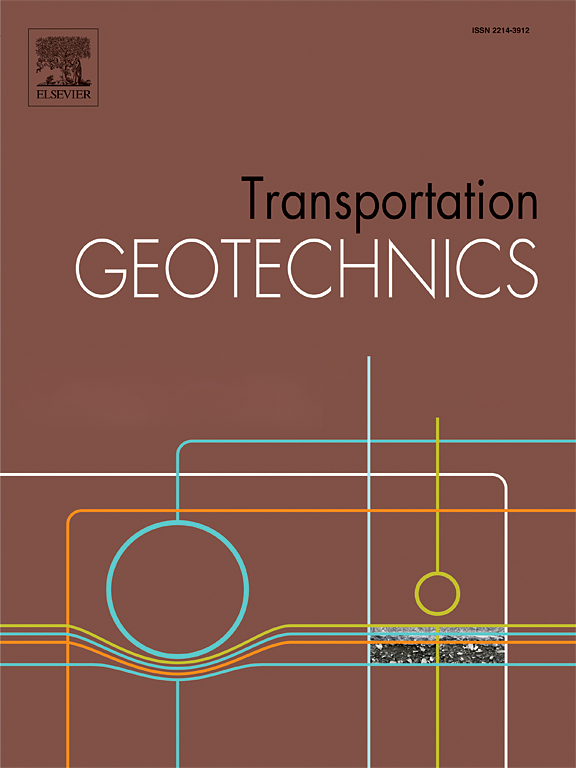基于CPTU的软土参数空间分布及扩展地基沉降变形规律研究
IF 4.9
2区 工程技术
Q1 ENGINEERING, CIVIL
引用次数: 0
摘要
针对旧道路改扩建工程中膨胀地基路基的沉降变形规律,本文基于压锥贯入试验(CPTU)对新老道路地基土进行了原位试验。利用地质统计学方法对该区域内锥形贯深仪尖端阻力和摩擦套阻力进行了插值和预测;这些插值结果随后被独立验证。根据插值结果对新旧路基的压缩模量和土层进行了分类。同时,利用地质统计学获得的路基土精细化分层结果,建立了覆盖全路段的离散元模型。结果表明,所建立的地质统计模型能较准确地预测锥贯仪尖端阻力和新旧路基土摩擦套阻力。独立验证结果的相关系数R2均大于0.87。压缩模量(ES)主要分布在0 ~ 20 MPa之间,随深度的增加而增大。总体而言,旧路基的ES大于新路基的ES。新老路基差异沉降较大,最大差异沉降为727.17 mm。在采用地统计土分类方法建立的两种扩展地基有限元模型的基础上,分析了新旧路基的水平位移和沉降。随着老公路的建成,旧路基的最大地面沉降量为280 mm。老路运行20年后,路面最大沉降量达到680 mm。改扩建工程后15年间,全线延长线基础沉降差异明显,沉降幅度在234 ~ 529 mm之间。在改造扩建工程中,利用有限勘探资料,应用地质统计学方法分析和研究扩建地基的沉降和变形规律,对控制扩建地基的沉降具有重要意义。本文章由计算机程序翻译,如有差异,请以英文原文为准。
Study on spatial distribution of soft soil parameters and settlement deformation law of extension foundation based on CPTU
In view of the subsidence and distortion laws of the subgrades of expansion foundation in the renovation and extension project of old roads, this paper conducts in-situ tests on the soil of the new and old road foundations based on the piezocone penetration test (CPTU). Geostatistics was used to interpolate and predict the tip resistance of the cone penetrometer and friction sleeve resistance within this region; these interpolation results were subsequently verified independently. In line with the interpolation outcomes, the compression modulus and soil layers of the new and old subgrade were categorized. Meanwhile, by leveraging the refined stratification findings of subgrade soil acquired through geostatistics, a discretized element model covering the whole road section was established. The findings demonstrate that the established geostatistics model can accurately predict the tip resistance of the cone penetrometer and friction sleeve resistance of new and old subgrade soil. Moreover, the correlation coefficient R2 of the independently verified results is greater than 0.87. The compression modulus (ES) is primarily distributed between 0 and 20 MPa, and increases with increases in the depth. Overall, the ES of the old subgrade exceeds that of the new subgrade. The differential settlement of new and old subgrades is large, and the maximum differential settlement is 727.17 mm. Based on the finite element model of the subgrades of both extension foundation created using geostatistical soil classification, the horizontal displacement and subsidence of the new and old subgrades were analysed. The maximum ground subsidence of the old subgrade is 280 mm, following the completion of the old road. After the old road has been in operation for 20 years, the maximum pavement settlement reached 680 mm. There is an evident differential subsidence of the extension foundation of the whole line, ranging between 234 mm and 529 mm in the 15 years after the renovation and extension project. In renovation and extension projects, it is of great significance for controlling the settlement of subgrades for both extension foundations to analyze and study their settlement and distortion laws by applying geostatistics based on limited exploration data.
求助全文
通过发布文献求助,成功后即可免费获取论文全文。
去求助
来源期刊

Transportation Geotechnics
Social Sciences-Transportation
CiteScore
8.10
自引率
11.30%
发文量
194
审稿时长
51 days
期刊介绍:
Transportation Geotechnics is a journal dedicated to publishing high-quality, theoretical, and applied papers that cover all facets of geotechnics for transportation infrastructure such as roads, highways, railways, underground railways, airfields, and waterways. The journal places a special emphasis on case studies that present original work relevant to the sustainable construction of transportation infrastructure. The scope of topics it addresses includes the geotechnical properties of geomaterials for sustainable and rational design and construction, the behavior of compacted and stabilized geomaterials, the use of geosynthetics and reinforcement in constructed layers and interlayers, ground improvement and slope stability for transportation infrastructures, compaction technology and management, maintenance technology, the impact of climate, embankments for highways and high-speed trains, transition zones, dredging, underwater geotechnics for infrastructure purposes, and the modeling of multi-layered structures and supporting ground under dynamic and repeated loads.
 求助内容:
求助内容: 应助结果提醒方式:
应助结果提醒方式:


